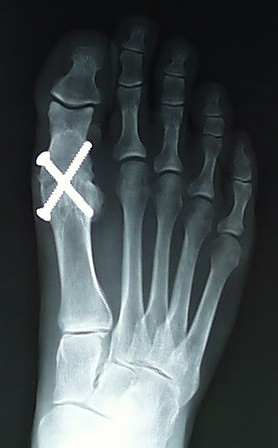
A first metatarsophalangeal joint (1st MTPJ) arthrodesis is a surgical procedure that involves fusing the bones of the big toe (metatarsal) and the first bone of the toe (phalanx) together to create a solid joint. This procedure is typically performed to treat advanced arthritis, instability, or deformity of the 1st MTPJ.
During the procedure, the surgeon makes an incision on the top of the foot and removes the damaged joint surfaces of the metatarsal and phalanx bones. The bones are then placed in the desired alignment and held in place with screws, pins, or plates until they fuse together. Over time, the bones grow together and form a solid joint, which can help relieve pain and improve the stability and function of the foot.
After the surgery, the foot is immobilized in a cast or boot for several weeks, and physical therapy may be recommended to help regain strength and mobility in the affected foot. While 1st MTPJ arthrodesis can be highly effective in treating certain conditions, it does limit the range of motion in the big toe and may affect the gait or balance of the patient. It is important to discuss the potential risks and benefits of 1st MTPJ arthrodesis with a qualified healthcare professional before undergoing the procedure.
